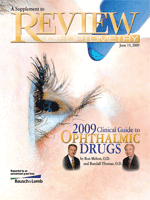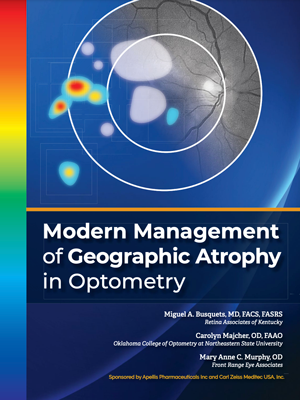Clinical Guide to Ophthalmic Drugs—June 2009
Read PDF Edition
Topical Antibiotics
It’s a shame there aren’t more bacterial eye infections—it would at least substantiate the high number of prescriptions for topical antibiotics. The truth is, bacterial eye infections are pretty uncommon.Adenoviral Infections: Take Charge of EKC
There is indeed an excellent, highly effective, easily applied and very cost-effectivetreatment for acute EKC. To maximize therapeutic response in viral infections,
initiate therapy early in the disease process.
Corticosteroids
Inflammation, either alone or as a component expression, is the most common ofocular conditions, so a masterful knowledge of the corticosteroids is of paramount
importance.
Combination Drugs
Perhaps half of all inflamed eyes require a combination drug, rather than anantibiotic or steroid alone.
Dry Eye and the Literature
Reducing inflammation is key to treating ocular surface damage. Here’s a sound, successful, literature-based protocol for patients with ocular surface dryness.The Simplicity of Allergy Management
If itching is the primary symptom, determine if it is an isolated symptom or if it isassociated with concurrent inflammatory signs.
Worldwide Perspective on Glaucoma
Much can be learned from a close and thorough survey of the glaucoma literature.Here are selected excerpts on recent research in the medical therapy of glaucoma.
Dear Friends,
Welcome to the 2009 edition of our “Clinical Guide to Ophthalmic Drugs.” On behalf of the optometric profession, we thank Review of Optometry as well as Bausch & Lomb for their commitment to consistently publish this annual clinical guide for the ultimate benefit of our patients.
Indeed, there have been some noteworthy milestones to occur over the past year. Cosopt is now generically available, as is TobraDex suspension. Another topical corticosteroid is now available, and a new chloro-fluoroquinolone has been born. A side effect of bimatoprost has been capitalized upon and is now marketed as an eyelash-enhancing medicine.
We continue to be impressed with how doctors of optometry have stepped up to the plate regarding expansion of medical services to their patients. Prescriptions are at an alltime high, and the growth rate is exciting. “Optometrists continue to grow in importance as providers of a wide range of eye and vision care services,” reads the February 2, 2009 AOA News. Specifically, “growth may be the most striking in the area of eye disease management and medical eyecare services.”
We, as a profession, have accomplished much—and yet much achievement still lies ahead. It is our perception that care for glaucoma and dry eye still suffer across the board. We encourage attentive and thoughtful introspection (and obsessive clinical consideration) regarding these two select areas of patient need.
Meanwhile, there is enormous interest in, and discussion of, the industry-doctor relationship. It is still very much in the crescendo phase. We feel it is important for us to share our personal perspectives with our family of optometry.
First and foremost, everything any of us do must be centered on how we treat our patients. We must remember that every human being we are privileged to care for is someone’s mother, father, daughter or son. Sometimes, in the hustle-bustle of the business aspects of running an office, the very essence of why we exist can be lost.
Second, we love to teach. Those who read our work or attend our lectures clearly understand this.
Third, we have worked with many optometry-related corporations over the past 20+ years, and have received monetary compensation for our professional services. There are some companies with whom we very much enjoy working; others, we avoid. We can speak enthusiastically about the products for which we know there is clinical value to the patient. We have never, and will never, make a statement about a drug or product that we feel is less than in the best interest of patient care, whether we receive compensation or not. We hope this statement of faithfulness to our patients and to our profession is received in the spirit in which it is intended.
As always, we hope the knowledge, experience, perspectives and insights we share herein allow you to continue to enhance the comprehensiveness and quality of your patient care.
Our very best wishes to each of you.
Sincerely,
Randall Thomas, O.D., M.P.H.
Ron Melton, O.D.
Educators in Primary Eye Care, L.L.C., www.eyeupdate.com
Additional Publications
-
Modern Management of Geographic Atrophy in Optometry
Hear from several experts, including Miguel A. Busquets, MD, Carolyn Majcher, OD, and Mary Anne C. Murphy, OD, about how to manage geographic atrophy using modern-day tools, technology, treatments and knowledge.
Sponsored by Apellis Pharmaceuticals Inc and Carl Zeiss Meditec USA, Inc Vision and Lifestyle Modern Presbyopic Patient
Reaping the Benefits of Serum Tears in Practice
The Value of Real Tears
A Wider View Of The Retina Advances Care
It’s Time to Talk to Your Patients about Digital Eye Strain



